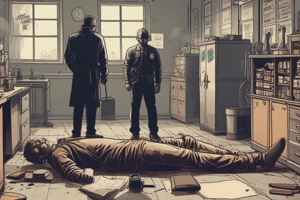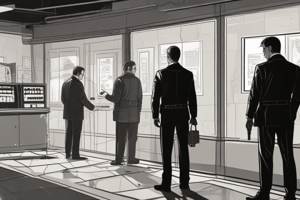Podcast
Questions and Answers
What are the three basic categories of drugs classified by their effect on the central nervous system?
What are the three basic categories of drugs classified by their effect on the central nervous system?
- Depressants, Stimulants, and Inhalants (correct)
- Narcotics, Anorectics, and Tranquillizers
- Stimulants, Depressants, and Hallucinogens
- Opiates, Amphetamines, and Barbiturates
What is a possible side effect of depressant drugs?
What is a possible side effect of depressant drugs?
- Slurred speech (correct)
- Euphoria
- Increased heart rate
- Nausea and vomiting
What type of drug is heroin?
What type of drug is heroin?
- Anorectic
- Stimulant
- Depressant (correct)
- Hallucinogen
What is the main objective of a preliminary investigation in drug cases?
What is the main objective of a preliminary investigation in drug cases?
What type of drug is dexedrine?
What type of drug is dexedrine?
What is a type of non-narcotic depressant drug?
What is a type of non-narcotic depressant drug?
What is the primary effect of hallucinogenic drugs on the central nervous system?
What is the primary effect of hallucinogenic drugs on the central nervous system?
Which of the following is a characteristic of marijuana leaves?
Which of the following is a characteristic of marijuana leaves?
What is the active chemical ingredient in marijuana?
What is the active chemical ingredient in marijuana?
What is the average THC content of hashish?
What is the average THC content of hashish?
Which of the following is a possible effect of stimulant drugs?
Which of the following is a possible effect of stimulant drugs?
What is the name of the act that replaced all previous Federal Narcotic Laws?
What is the name of the act that replaced all previous Federal Narcotic Laws?
What is the name of the drug that is often packaged in small paper packets or tin foil packets?
What is the name of the drug that is often packaged in small paper packets or tin foil packets?
What is the name of the process that produces hashish oil?
What is the name of the process that produces hashish oil?
What is the typical color range of hashish?
What is the typical color range of hashish?
What is the penalty for possession of under 35 grams of hashish?
What is the penalty for possession of under 35 grams of hashish?
What is the primary source of cocaine?
What is the primary source of cocaine?
What is the typical purity range of illicit cocaine?
What is the typical purity range of illicit cocaine?
What is the common effect of cocaine on the user?
What is the common effect of cocaine on the user?
What is the street term for crystal methamphetamine?
What is the street term for crystal methamphetamine?
What is the origin of most heroin in the US?
What is the origin of most heroin in the US?
What is the process of producing heroin?
What is the process of producing heroin?
What is the common effect of PCP on users?
What is the common effect of PCP on users?
What is the street term for PCP?
What is the street term for PCP?
Why is freebasing dangerous?
Why is freebasing dangerous?
What is speedballing?
What is speedballing?
What is the main risk associated with look-alike drugs?
What is the main risk associated with look-alike drugs?
What is a common indicator of drug manufacturing activity?
What is a common indicator of drug manufacturing activity?
What is a characteristic of heavy vehicle traffic associated with narcotic activity?
What is a characteristic of heavy vehicle traffic associated with narcotic activity?
What is a possible indication of drug use or manufacturing in a particular area?
What is a possible indication of drug use or manufacturing in a particular area?
What is a sign of potential drug activity in a neighborhood?
What is a sign of potential drug activity in a neighborhood?
What is the main reason why powders should be handled with caution?
What is the main reason why powders should be handled with caution?
What is the street name for the drug Methaqualone?
What is the street name for the drug Methaqualone?
What is the bi-phasic effect of combining Talwin with Pyrobenzamine?
What is the bi-phasic effect of combining Talwin with Pyrobenzamine?
What is the typical color of Preludin tablets?
What is the typical color of Preludin tablets?
What is the active ingredient in the Peyote Cactus?
What is the active ingredient in the Peyote Cactus?
What is the effect of Psilocybin Mushrooms on the brain?
What is the effect of Psilocybin Mushrooms on the brain?
What is the main hazard of using inhalants, such as glue or paint?
What is the main hazard of using inhalants, such as glue or paint?
What is the effect of Amyl Nitrate on the user?
What is the effect of Amyl Nitrate on the user?
What is the potential consequence of continued use of nitrates?
What is the potential consequence of continued use of nitrates?
What is the typical packaging of T's and Blues?
What is the typical packaging of T's and Blues?
Study Notes
Introduction to Drug Investigation
- This presentation covers the primary objectives of a criminal investigation and the procedure for conducting the investigation.
Classification of Drugs
- There are three basic categories of drugs, classified by their effect on the central nervous system:
- Depressant drugs
- Stimulant drugs
- Hallucinogenic drugs
Depressant Drugs
- Depressant drugs slow down the central nervous system reactions.
- Examples:
- Narcotic drugs (opium, morphine, heroin, codeine, analgesics)
- Non-narcotic depressants (barbiturates, tranquilizers, alcohol)
- Possible side effects:
- Slurred speech
- Disorientation
- Drunken behavior without the odor of alcohol
Stimulant Drugs
- Stimulant drugs increase the central nervous system reactions.
- Examples:
- Anorectic drugs (diet pills/weight control)
- Amphetamine drugs (biphetamine, dexedrine)
- Cocaine (local anesthetic)
- Possible effects:
- Increased alertness
- Excitation
- Euphoria
- Increased pulse rate and blood pressure
- Insomnia
- Loss of appetite
Hallucinogenic Drugs
- Hallucinogenic drugs distort the central nervous system reactions.
- Examples:
- LSD (lysergic acid diethylamide)
- PCP (phencyclidine)
- Psilocybin
- Possible effects:
- Illusions and hallucinations
- Poor perception of time and distance
- Violent, irrational behavior
Drug Types
- Cannabis (marijuana, hashish)
- Easily detected by acrid odor when burned
- Contains 61 unique chemicals, including THC (tetrahydrocannabinol)
- Cocaine
- Yellowish/white powder containing tiny, shiny, crystal-like particles
- Commonly used as a local anesthetic
- Heroin
- White or brown powdered substance from Southeast Asia, Middle East, Mexico
- Common names include smack, junk, h, horse
- PCP (phencyclidine)
- White powdered substance
- Developed in the 1950s as a veterinary anesthetic
- Methamphetamine (crystal speed)
- White powder with shiny crystal flakes
- Commonly used as a stimulant
Handling of Powders by Officers
- Don't taste powders
- Don't get powders on hands or other skin areas
- Remember powders can be "dumped" easily by defendants
- All powders should be suspect
Pills and Capsules
- Dexadrine (amphetamine)
- Commonly seen capsules
- Street terms: speeders, uppers, black beauties, yellow jackets
- Methaqualone (Quaaludes)
- Usually in white tablet form, marked "Lemmon 714" or "712"
- Street names: ludes
- Talwin (depressant)
- Small tan tablet scored with a "W" on one side and T21 on the other
- When combined with pryobenzamine, the result is a bi-phasic effect like heroin
- Street term: T's and Blues
Conditions/Indications Suggesting Narcotic Activity
- Heavy vehicle traffic to certain places
- Heavy pedestrian traffic to certain places
- Short duration of visits
- Time of activity (late night, after dark)
- Chemical containers in garbage
- Strong odors
- Late night activity
- Drug residue in area
- Large quantities of ice, used to cool chemicals in processing
Studying That Suits You
Use AI to generate personalized quizzes and flashcards to suit your learning preferences.
Description
This quiz covers the primary objectives of a criminal investigation, procedures for conducting an investigation, and the main objectives and steps taken in a preliminary investigation, with a focus on drug-related crimes.




